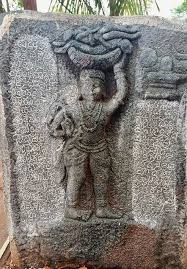Guttala Sculptural Inscription:

A 16th-century sculptural inscription found near Chandrashekara temple, Guttala (Haveri district, Karnataka), records the death of 6,307 people due to a drought in 1539 CE, making it India’s earliest epigraphic evidence of a humanitarian disaster.
Guttala Sculptural Inscription:
- Found near Chandrashekara temple, Guttala village, Karnataka.
- Written in Kannada script and language on a stone slab.
- Dated Saka 1461, August 18, 1539 CE.
- Records that 6,307 people died due to “bara” (drought).
- A local named Marulaih Odeya, son of Nanideva Odeya, buried the dead in baskets to earn merit for ruler Timmarasa Svami.
- Sculpture depicts Marulaih carrying a basket with dead bodies.
- Rare sculptural and textual record of a natural disaster in Indian history.
- Includes exact toll and social response.
- Depicts humanitarian act and local governance structure (mention of “seeme” – territorial unit).
- Offers visual iconography to complement textual epigraphy.




